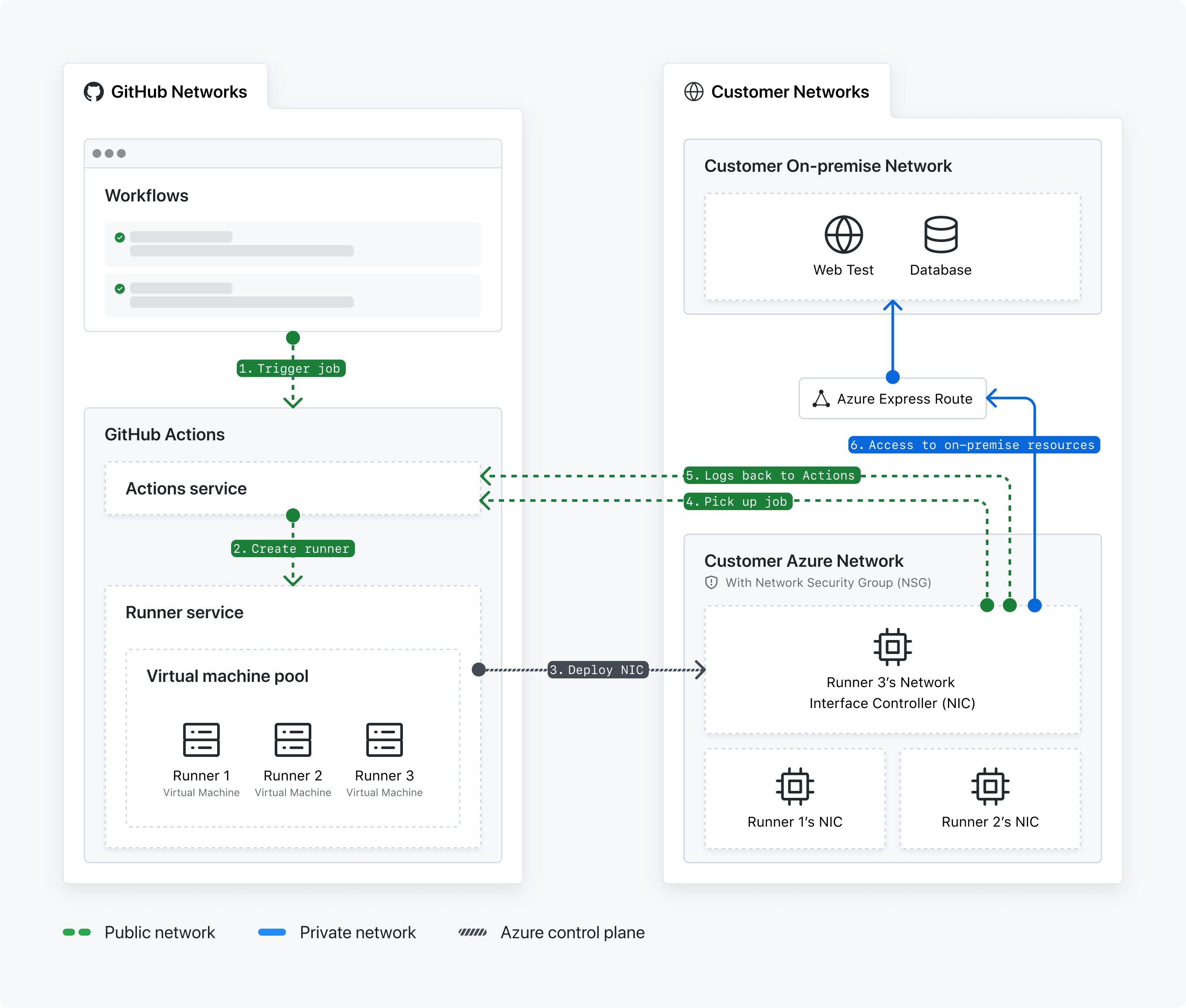About Azure private networking for GitHub-hosted runners
You can use GitHub-hosted runners in an Azure VNET. This enables you to use GitHub-managed infrastructure for CI/CD while providing you with full control over the networking policies of your runners. For more information about Azure VNET, see What is Azure Virtual Network? in the Azure documentation.
You can connect multiple VNET subnets to GitHub and manage private resource access for your runners via runner groups. For more information about runner groups, see Controlling access to larger runners.
Using GitHub-hosted runners within Azure VNET allows you to perform the following actions.
- Privately connect a runner to resources inside an Azure VNET without opening internet ports, including on-premises resources accessible from the Azure VNET.
- Restrict what GitHub-hosted runners can access or connect to with full control over outbound network policies.
- Monitor network logs for GitHub-hosted runners and view all connectivity to and from a runner.
About using larger runners with Azure VNET
2-64 vCPU Ubuntu and Windows runners are supported with Azure VNET. For more information on these runner types, see About larger runners.
Private networking for GitHub-hosted runners does not support static IP addresses for larger runners. You must use dynamic IP addresses, which is the default configuration for larger runners. For more information about networking for larger runners, see About larger runners.
About network communication
To facilitate communication between GitHub networks and your VNET, a GitHub-hosted runner's network interface card (NIC) deploys into your Azure VNET.
Because the NIC lives within your VNET, GitHub cannot block inbound connections. By default, Azure virtual machines will accept inbound connections from the same VNET. For more information, see AllowVNetInBound on Microsoft Learn. It is recommended to explicitly block all inbound connections to the runners. GitHub will never require inbound connections to these machines.
A NIC enables an Azure virtual machine (VM) to communicate with internet, Azure, and on-premises resources. This way, all communication is kept private within the network boundaries, and networking policies applied to the VNET also apply to the runner. For more information on how to manage a network interface, see Change network interface settings on Microsoft Learn.
Note
Multiple NICs may appear for a single job in your subscription because the GitHub Actions service over-provisions resources to run jobs. Once a runner is idle, the GitHub Actions service automatically de-provisions the resource and removes the corresponding NIC.

- A GitHub Actions workflow is triggered.
- The GitHub Actions service creates a runner.
- The runner service deploys the GitHub-hosted runner's network interface card (NIC) into your Azure VNET.
- The runner agent picks up the workflow job. The GitHub Actions service queues the job.
- The runner sends logs back to the GitHub Actions service.
- The NIC accesses on-premise resources.
About supported regions
The GitHub Actions service supports a subset of all the regions that Azure provides. To facilitate communication between the GitHub Actions service and your subnet, your subnet must be in one of the supported regions.
Note
If you use data residency on GHE.com, the supported regions are different. See Network details for GHE.com.
The following regions are supported on GitHub.com.
EastUsEastUs2WestUs2WestUs3CentralUsNorthCentralUsAustraliaEastJapanEastFranceCentralGermanyWestCentralNorthEuropeNorwayEastSwedenCentralSwitzerlandNorthUkSouthSoutheastAsiaKoreaCentral
Azure private networking supports GPU runners in the following regions.
EastUsWestUsNorthCentralUs
Azure private networking supports arm64 runners in the following regions.
EastUsEastUs2WestUs2WestUs3NorthCentralUs
If your desired region is not supported, please submit a request for new region availability in this GitHub form. You may also use global virtual network peering to connect virtual networks across Azure regions. For more information, see Virtual network peering in the Azure documentation.
About the GitHub Actions service permissions
In order to successfully deploy a NIC and join a NIC to a subnet, the GitHub Actions service maintains the following Azure role-based access control (RBAC) permissions in your Azure subscription. For more information about fine-grained access management of Azure resources, see Azure RBAC in the Azure documentation.
GitHub.Network/operations/readGitHub.Network/networkSettings/readGitHub.Network/networkSettings/writeGitHub.Network/networkSettings/deleteGitHub.Network/RegisteredSubscriptions/readMicrosoft.Network/locations/operations/readMicrosoft.Network/locations/operationResults/readMicrosoft.Network/locations/usages/readMicrosoft.Network/networkInterfaces/readMicrosoft.Network/networkInterfaces/writeMicrosoft.Network/networkInterfaces/deleteMicrosoft.Network/networkInterfaces/join/actionMicrosoft.Network/networkSecurityGroups/join/actionMicrosoft.Network/networkSecurityGroups/readMicrosoft.Network/publicIpAddresses/readMicrosoft.Network/publicIpAddresses/writeMicrosoft.Network/publicIPAddresses/join/actionMicrosoft.Network/routeTables/join/actionMicrosoft.Network/virtualNetworks/readMicrosoft.Network/virtualNetworks/subnets/join/actionMicrosoft.Network/virtualNetworks/subnets/readMicrosoft.Network/virtualNetworks/subnets/writeMicrosoft.Network/virtualNetworks/subnets/serviceAssociationLinks/deleteMicrosoft.Network/virtualNetworks/subnets/serviceAssociationLinks/readMicrosoft.Network/virtualNetworks/subnets/serviceAssociationLinks/writeMicrosoft.Network/virtualNetworks/subnets/serviceAssociationLinks/details/readMicrosoft.Network/virtualNetworks/subnets/serviceAssociationLinks/validate/actionMicrosoft.Resources/subscriptions/resourceGroups/readMicrosoft.Resources/subscriptions/resourcegroups/deployments/readMicrosoft.Resources/subscriptions/resourcegroups/deployments/writeMicrosoft.Resources/subscriptions/resourcegroups/deployments/operations/readMicrosoft.Resources/deployments/readMicrosoft.Resources/deployments/writeMicrosoft.Resources/deployments/operationStatuses/read
The following permissions will be present on two enterprise applications in your Azure tenant. You will see the enterprise applications your Azure tenant after configuring Azure private networking.
GitHub CPS Network Serviceid:85c49807-809d-4249-86e7-192762525474GitHub Actions APIid:4435c199-c3da-46b9-a61d-76de3f2c9f82
Using your VNET's network policies
Because the GitHub-hosted runner's NIC is deployed into your Azure VNET, networking policies applied to the VNET also apply to the runner.
For example, if your VNET is configured with an Azure ExpressRoute to provide access to on-premises resources (e.g. Artifactory) or connected to a VPN tunnel to provide access to other cloud-based resources, those access policies also apply to your runners. Additionally, any outbound rules applied to your VNET's network security group (NSG) also apply, giving you the ability to control outbound access for your runners.
If you have enabled any network logs monitoring for your VNET, you can also monitor network traffic for your runners.
GitHub-hosted runners use whatever outbound control your network is using. If your network relies on Azure's default outbound access, the IPs are not predictable and cannot be added to the GitHub IP allow list. For recommendations on using a stable outbound IP, see Default outbound access in the Azure documentation.
Using GitHub-hosted runners with an Azure VNET
To use GitHub-hosted runners with an Azure VNET, you will need to configure your Azure resources and then create a networking configuration in GitHub.
By default, organizations in an enterprise cannot create new network configurations and only inherit enterprise-level network configurations. Enterprise owners can set a policy that allows organizations in the enterprise to create network configurations that are independent of the enterprise. For more information, see Configuring private networking for GitHub-hosted runners in your enterprise.
For procedures to configure Azure private networking at the enterprise level, see Configuring private networking for GitHub-hosted runners in your enterprise.
For procedures to configure Azure private networking at the organization level, see Configuring private networking for GitHub-hosted runners in your organization.